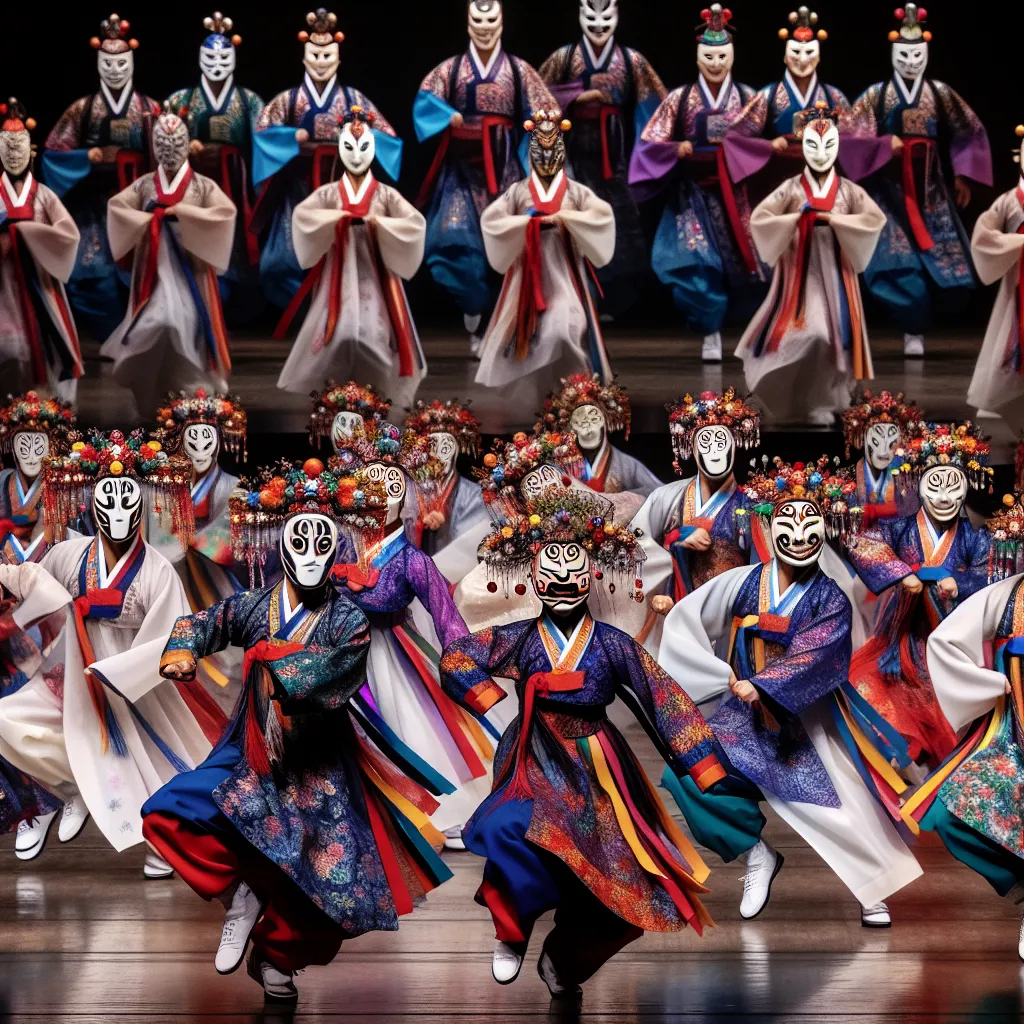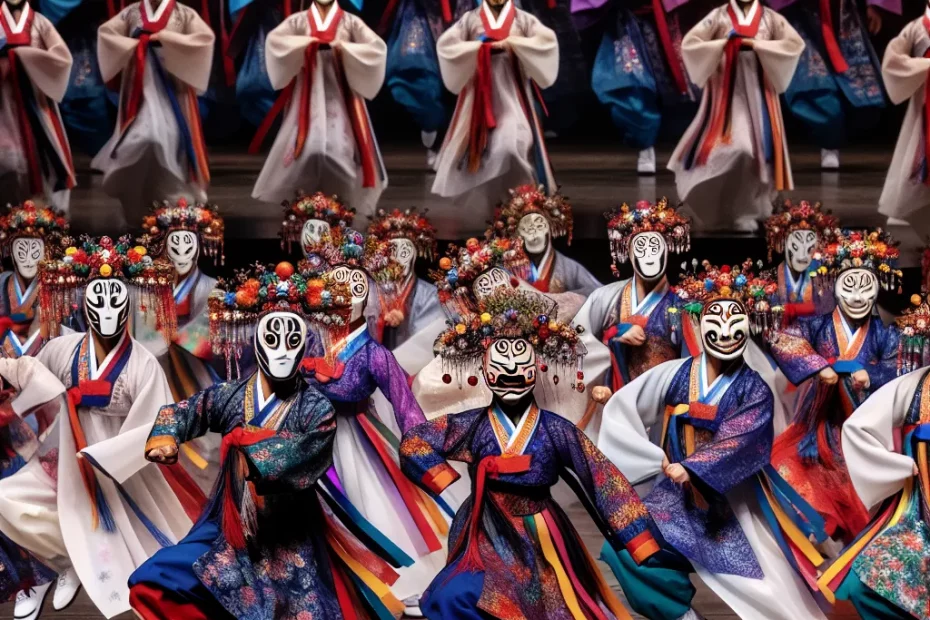The Heritage of Hahoe Mask Dance Drama: Celebrating Korea’s Folk Traditions
In the realm of Korean cultural heritage, the Hahoe Mask Dance Drama stands as a testament to the rich tapestry of traditions that have been passed down through generations. This unique art form, with its origins dating back centuries, offers a glimpse into the vibrant history and folklore of Korea. The intricate dance movements, accompanied by the mesmerizing masks, carry profound meanings and symbolism that reflect the values and beliefs of the Korean people. As efforts to preserve this cultural treasure continue, the impact of the Hahoe Mask Dance Drama on Korean society and its cultural identity remains significant. Embracing the essence of Korea’s folk traditions, this performance serves as a living legacy that celebrates the country’s cultural heritage and artistic prowess.

The Fascinating History of Hahoe Mask Dance Drama
Welcome to the enchanting world of Hahoe Mask Dance Drama, a cultural gem that shines brightly in Korea’s rich tapestry of folk traditions! Dating back over 600 years, this traditional Korean performance art has captivated audiences with its vibrant masks, dynamic movements, and deep-rooted historical significance. Let’s embark on a journey through time to explore the fascinating history of Hahoe Mask Dance Drama, where tradition meets artistry in a mesmerizing display of cultural heritage! 🎭🌟
Origin and Cultural Significance
Originating in the Hahoe Village in Andong, South Korea, Hahoe Mask Dance Drama has been designated as an Important Intangible Cultural Property of Korea, highlighting its profound cultural value. The masks used in this traditional performance are not mere accessories; they are symbolic representations of various characters, emotions, and societal roles. Each mask tells a story, embodying the spirits of ancestors and mythical beings, adding layers of depth to the performance. 👺👹
Evolution and Blend of Beliefs
The history of Hahoe Mask Dance Drama is steeped in tradition and ritual, with roots tracing back to the Joseon Dynasty. Originally performed as a shamanistic ritual to drive away evil spirits and bring blessings to the community, the dance drama evolved over the centuries, blending elements of Confucianism, Buddhism, and indigenous beliefs. Today, it stands as a living testament to Korea’s cultural heritage, preserving ancient rituals in a modern world. 🏮🎶
Choreography and Music
One of the most intriguing aspects of Hahoe Mask Dance Drama is the intricate choreography and music that accompany the performances. The dancers move with precision and grace, their movements synchronized to traditional Korean music played on traditional instruments like the janggu and the gayageum. The combination of fluid movements, rhythmic beats, and melodious tunes creates a sensory experience that transports the audience to a bygone era. 🎶💃
Legacy and Modern Appeal
As we delve deeper into the history of Hahoe Mask Dance Drama, we uncover a world where tradition, art, and spirituality intertwine to create a mesmerizing spectacle. The legacy of this ancient art form continues to thrive in modern times, captivating audiences with its timeless beauty and cultural significance. So, next time you find yourself in Korea, be sure to witness the magic of Hahoe Mask Dance Drama and immerse yourself in the living history of this cherished tradition! 🌺🎭
The Unique Masks Used in the Performance
In the mesmerizing world of the Hahoe Mask Dance Drama, the use of unique masks plays a pivotal role in bringing to life the rich cultural heritage of Korea. These masks, each with its own distinctive features and symbolism, add a layer of mystery and intrigue to the traditional performance. 🎭
The “Yangban” Mask
One of the most iconic masks used in the Hahoe Mask Dance Drama is the “Yangban” mask, representing the aristocratic class of the Joseon Dynasty. Adorned with a serene expression and intricate details, this mask symbolizes nobility and grace. Its exaggerated features, such as the high nose and small mouth, reflect the ideals of beauty and refinement of the time. 👑
The “Bune” Mask
Another prominent mask is the “Bune” mask, depicting a shamanistic figure believed to possess supernatural powers. With its bulging eyes and fierce expression, the Bune mask exudes a sense of mysticism and otherworldly energy. This mask is often used in rituals and ceremonies to ward off evil spirits and bring blessings to the community. ☯️
The “Halmi” Mask
The “Halmi” mask, representing an elderly woman, is characterized by its gentle smile and wise eyes. This mask symbolizes the matriarchal figure in Korean society, embodying wisdom, compassion, and strength. The Halmi mask is often used in performances to convey moral lessons and traditional values to the audience. 👵
In addition to these main masks, there are a variety of other masks used in the Hahoe Mask Dance Drama, each with its own unique characteristics and significance. From the playful “Yangban Talchum” mask to the fearsome “Chilseong” mask representing the Seven Stars, each mask adds depth and complexity to the performance, creating a visual spectacle that captivates the audience. 🌟
The craftsmanship and artistry involved in creating these masks are truly remarkable, with skilled artisans using traditional techniques passed down through generations to craft each mask by hand. The intricate designs, vibrant colors, and meticulous attention to detail make these masks not just props, but works of art in their own right. 🎨
Overall, the unique masks used in the Hahoe Mask Dance Drama are not just accessories, but powerful symbols that embody the spirit and essence of Korea’s folk traditions. Through their expressive features and symbolic meanings, these masks transport the audience to a bygone era, where myths and legends come to life in a mesmerizing display of culture and heritage. 🌺
Meaning and Symbolism Behind the Dance Movements
In the mesmerizing world of the Hahoe Mask Dance Drama, every movement holds a deep-rooted meaning and symbolism that transcends mere entertainment. The intricate choreography and gestures of the performers convey profound messages that reflect Korea’s rich cultural heritage and spiritual beliefs. Each dance movement is a carefully crafted symbol, steeped in tradition and history, offering a window into the soul of Korean folklore.
The Eternal Cycle of Life and Nature
The fluid movements of the dancers, accompanied by the rhythmic beats of traditional music, symbolize the eternal cycle of life and nature. As the performers gracefully glide across the stage, their gestures mimic the ebb and flow of the seasons, the growth of crops, and the harmony between humanity and the natural world. It is a visual symphony that celebrates the beauty of existence and the interconnectedness of all living beings.
The Power of Masks
The masks worn by the performers play a pivotal role in the dance drama, each mask representing a specific character or archetype. These masks are not mere disguises but powerful symbols that embody the spirits of ancestors, mythical creatures, and historical figures. Through the masks, the dancers channel the energy and essence of these beings, bringing them to life on stage and inviting the audience into a realm where the past and present coexist.
Symbols in Movement
The intricate footwork and hand gestures of the dancers are laden with symbolism, each step and movement telling a story or conveying a message. From the sweeping motions of a fan to the delicate placement of a hand, every gesture is imbued with meaning, inviting the audience to interpret and unravel the hidden narratives woven into the dance.
Themes of Human Experience
As the dance unfolds, themes of love, loyalty, betrayal, and redemption emerge, mirroring the universal human experience. The performers’ expressions, posture, and movements convey a range of emotions, from joy and sorrow to anger and forgiveness, creating a tapestry of feelings that resonate with audiences of all ages.
In essence, the Hahoe Mask Dance Drama is not just a performance but a living tradition that bridges the past with the present, the earthly with the divine. It is a celebration of Korea’s cultural legacy, a testament to the enduring power of storytelling through movement, and a reminder of the beauty and complexity of the human experience. Witnessing the dance is not just a visual spectacle but a spiritual journey, inviting us to reflect on our own place in the grand tapestry of existence.
Preservation Efforts and Impact on Korean Culture
In the realm of cultural heritage preservation, the Hahoe Mask Dance Drama stands as a shining example of Korea’s commitment to safeguarding its rich folk traditions. With a history dating back centuries, this traditional art form has been meticulously preserved through dedicated efforts and has left a profound impact on Korean culture.
Meticulous Preservation Efforts
The meticulous preservation efforts surrounding the Hahoe Mask Dance Drama have not only ensured the survival of this ancient tradition but have also contributed to the broader cultural landscape of Korea. Through meticulous documentation, restoration projects, and educational initiatives, the essence of the Hahoe Mask Dance Drama has been safeguarded for future generations to cherish and enjoy.
The impact of these preservation efforts on Korean culture cannot be overstated. The Hahoe Mask Dance Drama serves as a living testament to Korea’s vibrant cultural heritage, offering a window into the country’s past and providing valuable insights into its traditions and values. By preserving this art form, Korea has been able to maintain a strong connection to its roots and showcase its unique cultural identity to the world.
Furthermore, the Hahoe Mask Dance Drama has become a significant cultural export, attracting tourists and enthusiasts from around the globe. This not only boosts Korea’s tourism industry but also helps promote cross-cultural understanding and appreciation. The dance drama’s popularity has led to collaborations with international artists, further enriching the global cultural exchange.
In conclusion, the preservation efforts surrounding the Hahoe Mask Dance Drama have had a profound impact on Korean culture, ensuring the survival of this treasured tradition and showcasing Korea’s rich cultural heritage to the world. Through dedication, innovation, and a deep respect for tradition, Korea continues to celebrate and preserve its folk traditions for generations to come. 🎭🌟🇰🇷
In conclusion, the Hahoe Mask Dance Drama stands as a testament to Korea’s rich cultural heritage, showcasing the country’s deep-rooted folk traditions. The unique masks, intricate dance movements, and symbolic storytelling all come together to create a mesmerizing performance that has captivated audiences for centuries. Through ongoing preservation efforts, this traditional art form continues to thrive, leaving a lasting impact on Korean culture. As we celebrate the legacy of the Hahoe Mask Dance Drama, we also honor the importance of preserving and promoting such valuable cultural treasures for future generations to appreciate and enjoy.
